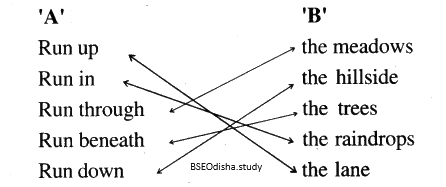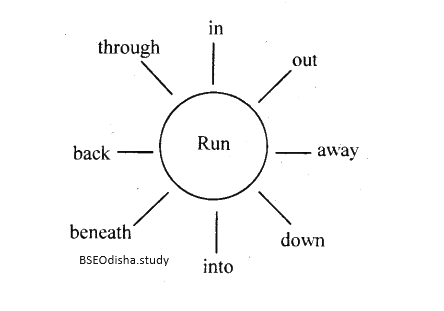7th Class English - Chapter 1 Run! Run! Run! All Question With Answer
II. While-Reading ( ପଠନକାଳୀନ): Text (ପାଠ୍ୟବସ୍ତୁ):
(ଅନୁବାଦ)
AWAY from the city
And into the sun.
Out of the country.
Run! Run! Run!
Run in the raindrops!
Run beneath the trees!
Run little races
With each little breeze!
Run down the hillside.
Run up the lane:
Run through the meadow,
Then run back again!
Run and be merry
All through the day!
Run to the country.
Away! Away!
(Mary Daunt)
ସହରରୁ ଦୂର
ଖରା ପ୍ରାନ୍ତରରେ
ଦେଶ ବାହାରେ
ଦୌଡ଼-ଦୌଡ଼-ଦୌଡ଼ !
ଦୌଡ଼ ବର୍ଷା ଟୋପାଟୋପାରେ
ଦୌଡ଼ ଗଛ ମୂଳ (ଛାଇରେ)
ଦୌଡ଼ ଅଳ୍ପ ଧୀର ବେଗରେ
ତାଳ ଦେଇ କୋମଳ ପବନ ସାଥିରେ!
ଦୌଡ଼ ପର୍ବତ/ପାହାଡ଼ କଡ଼େ କଡ଼େ
ଦୌଡ଼ ରାସ୍ତାର ଗଳିକନ୍ଦିରେ
ଦୌଡ଼ ଘାସୁଆ ପଡ଼ିଆ ଉପରେ
ପୁଣି ଫେରିଆସ ଦୌଡ଼ି ଦୌଡ଼ି !
ଦୌଡ଼ ଏବଂ ଆନନ୍ଦିତ ହୁଅ
ଦୌଡ଼ ଦିବା ଆଲୋକରେ !
ଦୌଡ଼ ମଫସଲ ଆଡକୁ,
ଦୂରକୁ ! ଦୂରକୁ !
(ମାରୀ ରାଉଣ୍ଡ)
↓ Question & Answer ↓
Question 1.
Who is the speaker in the poem?
(କବିତାରେ ବକ୍ତା କିଏ ?)
Answer:
The poet is the speaker in the poem.
Question 2.
How many times does the poet repeat the word “run”?
( କବି କବିତାରେ କେତେଥର ଦୌଡ଼ (run) ଶବ୍ଦକୁ ପୁନରାବୃତ୍ତି କରିଛନ୍ତି ?)
Answer:
The poet repeats the word ‘run’ twelve times.
Question 3.
Is the poet happy? Why? Why not?
(କବି କ’ଣ ଖୁସି ? କାହିଁକି ? କାହିଁକି ନୁହେଁ ?)
Answer:
Yes, the poet is happy to see a restless child who tries to keep himself full of activities.
Question 4.
Find in the second stanza the word that means ‘under’.
(ଦ୍ଵିତୀୟ ପଦରେ under (ତଳେ) ବୁଝାଉଥିବା ଶବ୍ଦଟିକୁ ଖୋଜ ।)
Answer:
The word ‘beneath’ means ‘under’ in the second stanza.
Question 5.
When should one run? Why do you run?
(କେତେବେଳେ ଜଣେ ଦୌଡ଼େ ? ତୁମେ କାହିଁକି ଦୌଡ଼ ?)
Answer:
One needs to run when one gets to be out of laziness We need to run to free our limbs (ଅଙ୍ଗପ୍ରତ୍ୟଙ୍ଗ) and minds (ମନକୁ ହାଲୁକା କରିବାକୁ).
Question 6.
There are some words about Nature described in the poem. One is the sun. What are the other words?
(କବିତାରେ ପ୍ରକୃତି ସମ୍ବନ୍ଧୀୟ କେତେକ ଶବ୍ଦ ବର୍ଣ୍ଣନା କରାଯାଇଛି । ଗୋଟିଏ ହେଉଛି ସୂର୍ଯ୍ୟ । ସେହିପରି ଅନ୍ୟ ଶବ୍ଦଗୁଡ଼ିକ କ’ଣ ?)
Answer:
The words related to Nature (ପ୍ରକୃତି) are raindrops, trees, breeze, hill-side, meadows (ପ୍ରାନ୍ତର).
Question 7.
Does the poet like to run in the raindrops? Why? Why not?
(କବି କ’ଣ ବର୍ଷାଟୋପାରେ ଦୌଡ଼ିବାକୁ ଚାହାଁନ୍ତି ? କାହିଁକି ? କାହିଁକି ନୁହେଁ ?)
Answer:
Yes, the poet always likes to run in the raindrops, because it gives him a nice feeling and merriment.
Question 8.
Why does the poet start and end the poem with the word “AWAY”?
(କବି କବିତାଟିର ଆରମ୍ଭ ଓ ସମାପ୍ତି – AWAY (ଦୂରେଇ ଦୂରେଇ) ଶବ୍ଦଦ୍ୱାରା ପରିପ୍ରକାଶ କରିଛନ୍ତି କାହିଁକି ?)
Answer:
The poet uses the word – AWAY – at the start and end of the poem because s/he wants to free the body and mind from routine life.
Question 9.
What does the poet want the readers to do?
(ପାଠକମାନେ କ’ଣ କରନ୍ତୁ ବୋଲି କବି ଚାହାଁନ୍ତି ?)
Answer:
The poet wants the readers to free themselves from routine life to real life and merry life.
Question 10.
Do you like running through the meadow? Why? Why not?
(ତୁମେ କ’ଣ ଘାସ ପ୍ରାନ୍ତରରେ ଦୌଡ଼ିବାକୁ ପସନ୍ଦ କର ? କାହିଁକି ? କାହିଁକି ନୁହେଁ ?)
Answer:
Yes, I like to run through the meadow as it serves like a soft mat and makes running enjoyable and harmless (ଅକ୍ଷତ).
Session – 2 (ଦ୍ଵିତୀୟ ପର୍ଯ୍ୟାୟ)
1. VMDT (ଦୃଶ୍ୟ ସ୍ମୃତି ବିକାଶ କୌଶଳ):
Whole: run into the sun, run beneath the tree, down the hillside
(ଖରାରେ ଦୌଡ଼, ଗଛ ଛାଇରେ ଦୌଡ଼, ପାହାଡ଼ | ପର୍ବତ କଡ଼ରେ ଦୌଡ଼)
Part : 3rd stanza- Close your eyes and put your finger on-hillside, lane, meadow
(ତୃତୀୟ ପଦ – ଆଖ୍ ବନ୍ଦ କରି ତୁମ ଅଙ୍ଗୁଳି ରଖ ପର୍ବତ ଶିଖରରେ, ଗଳିକନ୍ଦି ରାସ୍ତାରେ, ଘାସ ପ୍ରାନ୍ତରରେ )
MCQs: Choose the right answer from the options :
Question 1.
The poet wants to run ____________.
(A) into the city
(B) away from the sun
(C) in the raindrops
(D) down the riverside
Answer:
(C) in the raindrops
Question 2.
The poet is ____________.
(A) happy
(B) unhappy
(C) angry
(D) worried
Answer:
(A) happy
Question 3.
The word ’run’ has been used ____________ times in the poem.
(A) five
(B) eight
(C) twelve
(D) ten
Answer:
(C) twelve
Question 4.
Which word is similar in meaning to ‘green field’?
(A) lane
(B) meadow
(c) breeze
(D) merry
Answer:
(B) meadow
(a)TPR :
(Teacher demonstrates with instructions in English how to – run into the class, run in the class, run away from the class etc. Then s/he reads aloud the phrases and learners do the actions.) (ଶିକ୍ଷକ ନିଜେ ପ୍ରଦର୍ଶନ କରିବେ)
(i) ଶ୍ରେଣୀ ପ୍ରକୋଷ୍ଠରେ ଧାଇଁବା
(ii) ଶ୍ରେଣୀ ପ୍ରକୋଷ୍ଠ ବାହାରକୁ ଧାଇଁବା ଇତ୍ୟାଦି ।
1. Run in the class. – Students act.
(ଶ୍ରେଣୀ ଭିତରେ ଦୌଡ଼)- (ଛାତ୍ରମାନେ କରିବେ)
2. Run away from the class. – Students act.
(ଶ୍ରେଣୀ ବାହାରକୁ ଦୌଡ଼) – ( ଛାତ୍ରମାନେ କରିବେ )
3. Run back to the class. – Students act.
(ଶ୍ରେଣୀ ଆଡ଼କୁ ଦୌଡ଼) – (ଛାତ୍ରମାନେ କରିବେ)
4. Run into the class. – Students act.
(ଶ୍ରେଣୀ ଭିତରକୁ ଦୌଡ଼) – (ଛାତ୍ରମାନେ କରିବେ )
Listen to the poem and say how many times the word ‘run’ has been used in the poem. (କବିତାଟିକୁ ଧାନର ସହିତ ଶୁଣ ଏବଂ କୁହ ‘ଦୌଡ଼’ | Run ଶବ୍ଦଟି କେତେଥର ବ୍ୟବହୃତ ହୋଇଛି ।)
Answer:
Twelve times.
(b) Listen to the words and write in a good hand in your notebook. The teacher dictates the words- city, sun, country, tree, race, breeze, hill, lane, meadow, and merry.
(ଶବ୍ଦଗୁଡ଼ିକୁ ଧାନର ସହିତ ଶୁଣ ଏବଂ ସୁନ୍ଦର ଅକ୍ଷରରେ ତୁମ ଖାତାରେ ଲେଖ । ଶିକ୍ଷକ ଉଚ୍ଚାରଣ କରିବେ- ସିଟି, ସନ୍, କଣ୍ଟି, ଟ୍ରି, ରେସ୍, ବ୍ରିଜ୍, ହିଲ୍, ଲେନ୍, ମେଡ଼ା, ମେରି ।)
4. Speaking (କହିବା) :
(a) Reading aloud (ଉଚ୍ଚ ସ୍ବରରେ ପଢ଼ିବା)
Teacher reads aloud one line, students repeat after him/her in chorus. (ଶିକ୍ଷକ ଗୋଟିଏ ଧାଡ଼ି ପଠନ କରିବେ, ଛାତ୍ରଛାତ୍ରୀମାନେ ମିଳିତ ସ୍ବରରେ ପୁନରାବୃତ୍ତି କରିବେ ।)
(b) Chain-drill (ଶୃଙ୍ଖଳ ଅଭ୍ୟାସ)
“Run and be merry all through the day.” (ଦୌଡ଼ ଏବଂ ଖୁସି ହୁଅ ଦିନସାରା ।)
(c) Rhyming words (ଯତିପାତ ପଡ଼ୁଥିବା ଶବ୍ଦାବଳୀ)
(Teacher reads aloud the rhyming words and students repeat after him in chorus)
sun – run, trees – breeze, lane – again, day – away (ସନ୍-ରନ୍, ଟ୍ରିଜ୍-ବ୍ରିଜ୍, ଲେନ୍-ଏଗେନ୍, ଡେ-ଆୱେ)
5. Vocabulary (ଶବ୍ଦଜ୍ଞାନ) :
(a) Match the following phrases under ’A’ with phrases under ‘B’. One is done for you.
(‘A’ର ଶବ୍ଦାବଳୀ ସହିତ ‘B’ର ସମ୍ବନ୍ଧିତ ଶବ୍ଦାବଳୀକୁ ମିଳାଅ ।) (ପ୍ରଶ୍ନ ସହ ଉତ୍ତର)
Answer:

(b) Given below a list of words on the left. Write their meanings choosing from brackets against each word. (ବାମ ପାର୍ଶ୍ଵରେ କିଛି ଶବ୍ଦାବଳୀ ଅଛି ।ସେଗୁଡ଼ିକର ଅର୍ଥ ବନ୍ଧନୀ ମଧ୍ଯରୁ ବାଛି ପ୍ରତ୍ୟେକ ଶବ୍ଦ ପାର୍ଶ୍ଵରେ ଲେଖ ।)
(green field, cool air, road, cheerful)
merry: __________________
lane: ____________________
breeze: __________________
meadow: __________________
Answer:
merry: cheerful
breeze: cool air
lane: road
meadow: green field
(c) Given below are some words. Pair them together according to the way they are pronounced.
(ନିମ୍ନରେ କେତେକ ଶବ୍ଦ ଦିଆଯାଇଛି । ଉଚ୍ଚାରଣ ଅନୁଯାୟୀ ସେଗୁଡ଼ିକୁ ଯୋଡ଼ି ଯୋଡ଼ି କରି ଦର୍ଶାଅ ।)
away, sun, trees, run, again, breeze, day, lane
____________________________________
____________________________________
____________________________________
____________________________________
Answer:
away — day,
sun — run
trees — breeze,
again — lane
(d) Mark the underlined word in the following sentence. (ନିମ୍ନ ବାକ୍ୟଗଡ଼ିକରୁ ରେଖାଙ୍କିତ ଶବ୍ଦକୁ ଚିହ୍ନଟ କର ।)
Run down the hillside.
The word hillside is – hill + side.
Now you add ‘side’ with the words – river, country, sea, road, and lake and write the new words. One is done for you.
ପ୍ରଦତ୍ତ ଶବ୍ଦଗୁଡିକରେ side ଯୋଗକରି ନୂତନ ଶବ୍ଦ ଲେଖ ।
river + side = riverside
_______________________
_______________________
_______________________
_______________________
Answer:
river + side = riverside
country + side = countryside
sea + side = seaside
road + side = roadside
lake + side = lakeside
(e) Order the jumbled letters and make words. One is done for you.
(ଗୋଳମାଳିଆ ଅକ୍ଷରଗୁଡ଼ିକୁ ସଜାଇ ଉପଯୁକ୍ତ ଶବ୍ଦ ଗଠନ କର ।)
(yad, tunyrco, nur, snu, ityc, rete, neal, doweam)

Answer:
yad – day
tunyrco – country
nur – run
snu – sun
ityc – city
rete – tree
neal – lane
doweam – meadow
6. Usage (ପ୍ରଚଳିତ ପ୍ରୟୋଗ)
(a) Change the following lines like the example.
(ଉଦାହରଣ ମୁତାବକ ନିମ୍ନ ଧାଡ଼ିଗୁଡ଼ିକୁ ବଦଳାଅ ।)
I run into the sun.
Example: I am running into the sun.
- I go to my school with my friends.
Answer:
I am going to my school with my friends. - We play in our school playground.
Answer:
We are playing in our school playground. - I come back my home.
Answer:
I am coming back my home. - I wash my hands and legs.
Answer:
I am washing my hands and legs. - I pray to God with my parents.
Answer:
I am praying to God with my parents.
(b) Read the poem and write the words which go with ‘run’. One is – done for you. (କବିତାଟିକୁ ପାଠ କରି run ଅନ୍ୟ ଶବ୍ଦ ସହିତ ମିଶାଇ ଲେଖ । ତୁମ ପାଇଁ ଲେଖାଥିବା ଉଦାହରଣକୁ ଲକ୍ଷ୍ୟ କର ।)
Answer

7. Writing (ଲିଖନାତ୍ମକ) :
(a) Read the following lines of the poem. They are not in order. Order them. You may see the poem if necessary. (କବିତାର ନିମ୍ନ ଧାଡ଼ିଗୁଡ଼ିକୁ ପାଠ କର । ସେଗୁଡ଼ିକ ଠିକ୍ କ୍ରମରେ ନାହିଁ । ଠିକ୍ କ୍ରମରେ ସଜାଅ ଆବଶ୍ୟକସ୍ଥଳେ କବିତାଟିକୁ ଦେଖପାର ।)
With each little breeze!
Run beneath the trees!
Run little races
Run in the raindrops!
Answer:
Run in the raindrops!
Run beneath the trees!
Run little races
With each little breeze!
b) Change the underlined words of the stanza using your own words and get your new poem and get your new poem. (ପଦଟିରେ ବ୍ୟବହୃତ ନିମ୍ନ ରେଖାଙ୍କିତ ପଦଗୁଡ଼ିକ ବଦଳରେ ନିଜସ୍ୱ ଶବ୍ଦ ବ୍ୟବହାର କରି ନିଜସ୍ବ ନୂତନ ପଦଟିକୁ ଲେଖ ।)
Run down the hillside.
Run up the lane:
Run through the meadow.
Then run back again!
_____________________________________
_____________________________________
_____________________________________
_____________________________________
Answer:
Run down the valley.
Run up the field:
Run through the forest.
Then run back mild! (ଉଦାସ)